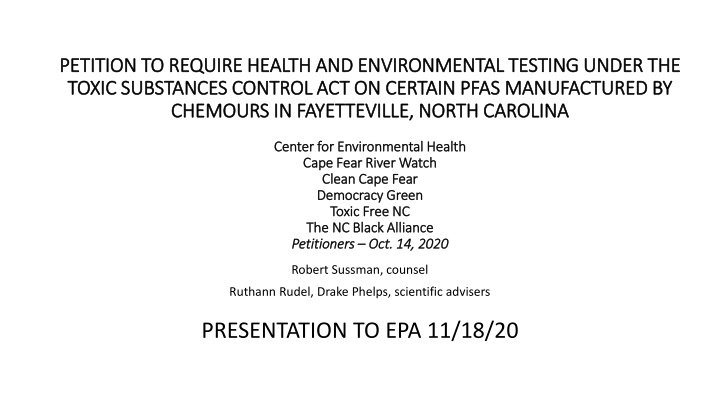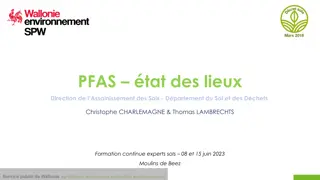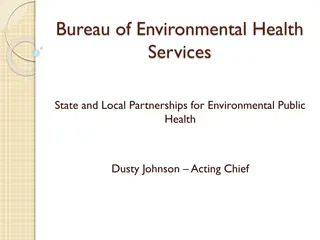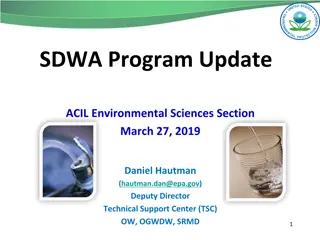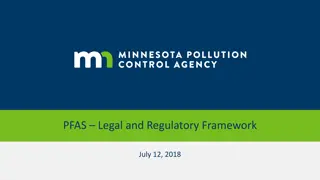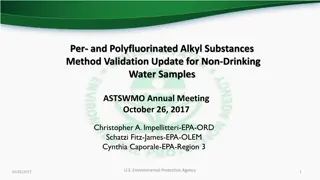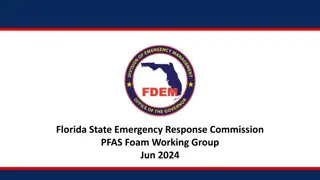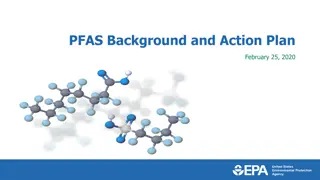Petition to Require Health and Environmental Testing for PFAS Manufactured by Chemours in Fayetteville, NC
This petition under the Toxic Substances Control Act urges testing of 54 PFAS linked to Chemours' facility in Fayetteville, NC. It highlights potential health and environmental risks, emphasizing the need for comprehensive testing by an independent panel. Data sources include public utility records, Chemours documents, and peer-reviewed literature. The petition aims to fill knowledge gaps and safeguard communities downstream of the Cape Fear River.
Download Presentation

Please find below an Image/Link to download the presentation.
The content on the website is provided AS IS for your information and personal use only. It may not be sold, licensed, or shared on other websites without obtaining consent from the author.If you encounter any issues during the download, it is possible that the publisher has removed the file from their server.
You are allowed to download the files provided on this website for personal or commercial use, subject to the condition that they are used lawfully. All files are the property of their respective owners.
The content on the website is provided AS IS for your information and personal use only. It may not be sold, licensed, or shared on other websites without obtaining consent from the author.
E N D
Presentation Transcript
PETITION TO REQUIRE HEALTH AND ENVIRONMENTAL TESTING UNDER THE PETITION TO REQUIRE HEALTH AND ENVIRONMENTAL TESTING UNDER THE TOXIC SUBSTANCES CONTROL ACT ON CERTAIN PFAS MANUFACTURED BY TOXIC SUBSTANCES CONTROL ACT ON CERTAIN PFAS MANUFACTURED BY CHEMOURS IN FAYETTEVILLE, NORTH CAROLINA CHEMOURS IN FAYETTEVILLE, NORTH CAROLINA Center for Environmental Health Center for Environmental Health Cape Fear River Watch Cape Fear River Watch Clean Cape Fear Clean Cape Fear Democracy Green Democracy Green Toxic Free NC Toxic Free NC The NC Black Alliance The NC Black Alliance Petitioners Petitioners Oct. 14, 2020 Oct. 14, 2020 Robert Sussman, counsel Ruthann Rudel, Drake Phelps, scientific advisers PRESENTATION TO EPA 11/18/20
Overview of Petition Based on TSCA section 21 Focused on Chemours manufacturing facility in Fayetteville, NC and impact of PFAS environmental releases on downstream Cape Fear communities Proposes testing of 54 PFAS linked to facility under TSCA rule or order Demonstrates that the 54 PFAS meet section 4 testing criteria May present an unreasonable risk to health or the environment Insufficient information or experience to determine health and environmental effects Testing is necessary to fill information gaps Seeks to require Chemours to fund and carry out testing with independent NAS panel providing oversight and direction 2
Selection of 54 Chemicals Three sources of data Public utility data and data from private well owners Publicly available documents from Chemours Peer-reviewed literature 3
Peer-reviewed literature Strynar et al. (2015) One of first reports of novel PFAS in the Cape Fear River Sun et al. (2016) First to show that Wilmington drinking water contained novel PFAS, including GenX McCord & Strynar (2019) May 2017 sampling identified 37 to 58 different PFAS in the Cape Fear River Kotlarz et al. (2020) Legacy and novel PFAS found in participants serum and drinking water 4
Publicly available documents from Chemours Largely come from the Consent Order with NCDEQ Methods for detecting their own PFAS Letters to NCDEQ regarding compliance with Consent Order Reports on emissions to air and water Analytical results of groundwater, wastewater, stormwater, and soil around the facility 5
Public utility and private well data Contamination is ongoing Cape Fear Public Utility Authority (CFPUA) Brunswick County Utility (H2Go) Private well owners near Fayetteville Works 6
Tier Classification Tier 1 known human exposure as measured by blood, food, or drinking water (14 PFAS) Tier 2 probable human exposure based on detection in the environment (40 PFAS) Master Testing List in petition provides identifying information for 54 PFAS and documents basis for known or probable human exposure Petition does not include legacy PFAS (PFOS, PFOA) found in Cape Fear River but not linked to ongoing production Chemours has found another 257 potentially unique unknown PFAS in environmental releases but these cannot be tested due to lack of test standards 7
Toxicity Testing Strategy Goal: Smallest number of tests and greatest likelihood of identifying the most sensitive effect Identified critical effects used to derive PFOA, PFOS, GenX drinking water guidance values Liver, kidney, serum biochemistry Immune effects Pup survival and weight 4 days after birth Thyroid and other hormone measures Developmental including mammary gland, neurotoxicity, immunotoxicity, and reproduction Cancer 54 PFAS in petition deemed to have potential for these effects based on data for other PFAS and common characteristics of class Identified study types that were the basis for these effects 8
The basic toxicology test set 28-day repeated dose Captures liver and kidney effects, blood biochemistry (cholesterol, ALT, glucose, cytokeratin 18 M30, tumor necrosis factor , and interleukin 8), some immune and hormone Screening reproduction and development 4-day pup survival and body weight 28-day immunotoxicity Toxicokinetics (related serum level with intakes by inhalation, dermal, and oral) All tox studies required to measure internal dose (usually serum) All tox studies oral except if to a volatile PFAS then inhalation Includes measures in pregnancy Required for 54 PFAS detected in human serum, drinking water, local food, the river and other media that also have some documentation that they originated from Chemours Also required for three mixtures: downstream drinking water, serum mixture from biomonitoring, the mixture that adjacent residents were exposed to Mixture testing will account for synergistic and additive effects of real-world exposure to multiple PFAS 9
Other testing and info Basic ecological effect screens required under EPA consent order for GenX Physical-chemical properties (Is it volatile? Soluble in xx?) Basic fate and transport (e.g. Does it bioaccumulate?) also required in GenX consent order Develop analytical standard and measurement method where unavailable (necessary to carry out testing) 10
14 PFAS measured in drinking water or in human biomonitoring 2-year cancer bioassay Multigeneration reproduction and development Neurodevelopment Mammary gland development More extensive testing warranted for Tier 1 compounds in light of evidence of widespread exposure Selected endpoints have raised concern in studies on other PFAS and formed the basis for previous assessments and exposure guidelines 11
Human studies TSCA section 4(b)(2)(A) authorizes EPA to require human epidemiology studies Important way to identify health effects associated with multiple PFAS exposure and take into account unique human susceptibilities DuPont Parkersburg C8 study provides successful model for Cape Fear area Proposed study design for Cape Fear human study: At least 100,000 participants (of ~300,000 exposed) Biomonitoring Health outcomes from medical records plus from the serum sample Special subgroup study for adjacent residents (vs. downstream) Pharmacokinetics in workers to try to derive half-life in humans 12
